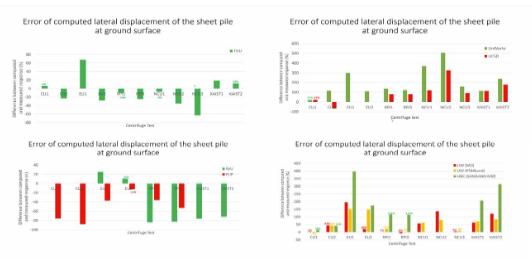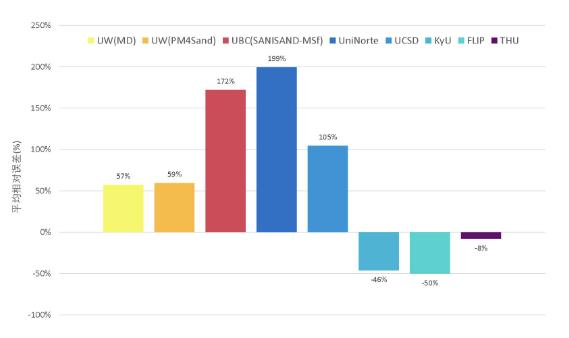In the 2022 International Liquefaction Experiments and Analysis Project (LEAP), Drs. ZHANG Jianmin and WANG Rui’s team from the Department of Hydraulic Engineering at Tsinghua University achieved the best prediction of seismic response in structures on saturated sandy soil foundations among 15 teams worldwide. The International Liquefaction Experiments and Analysis Project (LEAP) is a significant international collaborative initiative in the field of seismic geotechnical engineering. Targeting the critical phenomenon of soil liquefaction in sandy soils, which leads to seismic damage to engineering structures, LEAP aims to test and evaluate the modeling capabilities of current advanced constitutive models for sandy soils and numerical simulation methods regarding the response of sandy soil to seismic liquefaction and its impact on structures. The project was initiated in 2015 and has undergone five phases. Each phase involves the collaborative participation of approximately 20 research teams from around the world in both experiments and consecutive back-to-back predictions. The theoretical and technical contributions from the Tsinghua team have demonstrated outstanding advantages in all five phases of the LEAP project. The LEAP-2022 project, focusing on the seismic response of pile-supported retaining walls in saturated sandy soil foundations, conducted 11 centrifuge model tests by five research institutions. Participating numerical analysis teams, under conditions where the experimental results were unknown, carried out back-to-back predictions of the responses of the foundation and retaining wall using their respective constitutive models and numerical simulation methods. On January 26, 2023, LEAP-2022 officially released the comparison between the predictions and experimental results of all teams in this phase of the project.

LEAP-2022 Project: Experimental model of pile-supported retaining wall in saturated sandy soil foundation
In this phase of the LEAP-2022 project, the team from the Department of Hydraulic Engineering at Tsinghua University utilized an original large deformation constitutive model for sandy soil liquefaction and an adapted fluid-structure coupled dynamic numerical simulation method to predict the results of 11 experiments. The officially released prediction results indicate that the average prediction error of wall displacement in the dynamic centrifuge model tests by the Tsinghua team for this project is 8%, much lower than that of teams from the United States, Europe, Japan, and others. This highlights the team's advantages in sandy soil liquefaction theory and numerical simulation technology. This successful prediction is built on the team's long-term systematic research on the macro and micro phenomena of seismic liquefaction in sandy soil, constitutive laws for large deformation liquefaction, generation mechanisms, mathematical modeling, and numerical algorithms.

Officially released by the LEAP-2022 project, the global teams’ relative errors in predicting the results of 11 experiments are shown. The top left corner represents the results of the Tsinghua University team (THU).

LEAP-2022 project: Global teams’ average relative prediction errors, with the Tsinghua University team (THU) shown on the rightmost side.
The research team led by Drs. ZHANG Jianmin and WANG Rui from the Department of Hydraulic Engineering at Tsinghua University has long focused on soil dynamics and geotechnical earthquake engineering. They have achieved research milestones in fundamental soil dynamics theories, such as large deformation constitutive relationships for sandy soil liquefaction, soil dynamic strength mechanisms, and failure criteria. The team has established integrated seismic design theories and methods for structures and soils, developed a high-performance dynamic fluid-structure coupled computational platform for geotechnical earthquake engineering, and realized simulations of the static and dynamic interactions between superstructures and soils in large-scale systems. These achievements have been applied to the design and evaluation of significant projects, including the comprehensive transportation hub in the Beijing Urban Sub-center, the ML Reservoir dam, the Shenzhen to Zhongshan Cross-River Passage, and coral sand islands and reefs. In the case of the West Artificial Island project for the Shenzhen to Zhongshan Cross-River Passage, the deformation predictions provided in the analysis report submitted to the design unit before construction were consistent with on-site monitoring results. Compared to traditional methods, this achieved an order of magnitude improvement in deformation prediction accuracy. The team’s large deformation constitutive model for sandy soil liquefaction has gained international recognition in the LEAP project and has been applied by scholars from over ten institutions in the United States, Greece, Canada, Australia, Iran, Egypt, and China. The Tsinghua University team participating in the LEAP-2022 project also includes doctoral students HUYAN Bin and YU Jiake from the Department of Hydraulic Engineering.